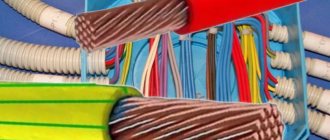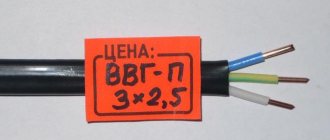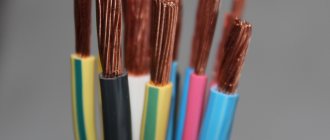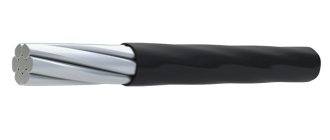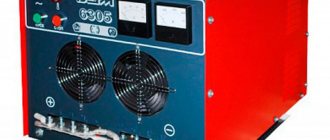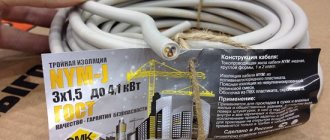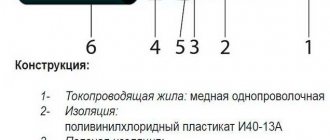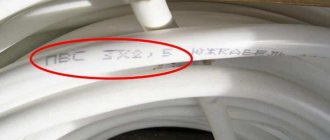The main element of any electrical wiring is cable products. Depending on the purpose, location and type of wiring, conductors of certain types are selected. In areas that consist of numerous irregularities, it is customary to lay the most flexible wires.
The PV wire is characterized by increased flexibility, which is its undoubted advantage compared to several foreign and domestic analogues. Another obvious advantage of this product is its versatility.
Marking designation
Let's start with deciphering the abbreviation. Questions may arise due to the additional numbers that are added after the two main capital letters. Let's get started:
- The letter “P” in the first place indicates that the product is a wire. In addition to wires, these products are divided into two categories - cords (W) and cables (C).
- The letter "B" in second place indicates the type of insulation used. In this case we are talking about a polyvinyl chloride shell, the positive quality of which is its resistance to many physical and chemical influences. This is one of the main materials used as a dielectric.
- The last digit indicates the cable flexibility class - from “1” to “5”. The higher this value, the more flexible the product will be.
Wires are divided into two main categories - installation and installation. The first category includes products that can be used for a long period of time in the same place. We are talking, for example, about installing a socket, switch, etc. The installation wire is intended for repeated use and temporary connection of various equipment.
It is logical that a more flexible cable should be called an installation cable, while a more rigid product should be called an installation cable. For example, PV1 is an installation wire, which is not recommended to be constantly moved and used in different places, PV3 is an installation wire.
Wire storage and transportation conditions
During storage, the cable drum should stand and not lie down. It is allowed to store such wires outdoors, under a canopy, so that they are not exposed to precipitation.
During storage, the ends of the wire must be protected from external influences (ultraviolet rays, water, chemicals).
Important! Wires with fiber, enamel protection and sheathing made of other moisture-absorbing compounds should be stored only in warehouses.
Transporting cables in a reel
When opening the cable package, you need to place plywood or a board under the drum.
Important! If the packaging is damaged, it is not recommended to use this product.
The room temperature should be at least 15 degrees. Humidity is not allowed, because it causes fungi and mold to develop. It is also necessary to check whether there are any rodents in the warehouse.
From time to time it is recommended to check the product for mechanical damage. Since, if they are present, this can significantly reduce the service life of the product and lead to unpleasant consequences.
You may be interested in Description of the PUNP wire
Important! Transportation is carried out only in a special truck, where the drum is placed using a loader. Next, the coils need to be secured with cables so that they are not damaged.
Proper storage
Do not try to drag or roll the coils on the ground yourself, as this may damage the outer rubber layer.
Varieties
PV is the general name for wires with high-quality polyvinyl chloride insulation. If we look deeper, there are a huge number of varieties of this product: there are both installation and installation products. All of the wires listed below are successfully used in AC electrical networks with voltages up to 450 V:
- PV1 is an installation wire used in an electrical network with a voltage of 450 V and a frequency not exceeding 100 Hz. In the case of DC networks, PV1 can be used at voltages up to 1000 V. The maximum permissible current value is 41 A. The cores are made of tinned copper. Any PV1 is single-core, and the conductor consists of several small wires.
- PV3 is an analogue of PV of the first class of flexibility. In terms of basic technical and operational parameters, it is in no way inferior to PV1, but it can be used as an installation product.
- BPVL – on-board wire. Its name is due to its original purpose: the cable was used in aircraft construction. Over time, it began to be used when switching stationary equipment. The maximum permissible voltage in AC networks is 250 V at a frequency of 2000 Hz, DC - 500 V.
- APVBBShv is a power wire whose cores are made of aluminum. The main purpose is to transport energy through stationary electrical installations in alternating current power networks with voltage and frequency not exceeding 1000 V and 50 Hz, respectively. A cable with a similar marking, but without the letter “A” is in first place - the same product, but made of copper conductors.
- APV is an aluminum installation wire with parameters similar to copper products. The main difference between aluminum products is that the maximum permissible voltage at alternating current is 400 V (instead of 450) at a frequency of 50 Hz (instead of 100).
- KSPV is a high-quality wire that is used in the installation of alarm and video surveillance systems. Contains two-layer insulation: the inner shell is made of polyethylene, the outer shell is made of polyvinyl chloride. Often the outer insulation is white.
The best manufacturers of analog products
The PUV conductor came to replace PV 1 with the same parameters and purpose. If you need installation in places with difficult access, the PUGV or PV 3 conductor will suit you.
What is the difference between PUV and PUGV? And they differ in the degree of flexibility. In the first case this indicator is one, in the second – five. The remaining parameters are almost the same.
Among the domestic manufacturers of these products, the following enterprises can be noted:
- Open joint-stock company "Podolsk cable", located in Podolsk.
- Joint Stock Company "Rosskat"
- Limited liability company "Dmitrov cable", city of Dmitrov.
For today, this is all the information that we wanted to share with you regarding the characteristics of installation wires. Ask your questions in the comments under the article or on our forum, we will definitely try to help you.
Nomenclature of wires PV1
Next, we will consider the main types of PV1 wires (first class of flexibility), which are produced by domestic manufacturers. All products comply with GOST.
First, pay attention to the table, which shows the relationship between the cross-sectional area of PV1 and mass:
| Section, sq. mm | Maximum outer diameter, mm | Weight of 1 km cable, kg |
| 0,5 | 2,4 | 8 |
| 0,75 | 2,6 | 10 |
| 1,0 | 2,8 | 13 |
| 1,5 | 3,3 | 19 |
| 2,0 | 3,3 | 26,2 |
| 2,5 | 3,9 | 30 |
| 3,0 | 3,9 | 37,7 |
| 4,0 | 4,4 | 45 |
| 5,0 | 4,4 | 54,8 |
| 6,0 | 4,9 | 65 |
| 8,0 | 4,9 | 80,2 |
| 10 | 6,4 | 107 |
| 16 | 8 | 172 |
| *** | *** | *** |
| 120 | 17,5 | 1060 |
The first thing you must remember: any PV1 wire is a single-core product. Unfortunately, this fact overshadows its domestic use, since the presence of only one core is in itself a limiting factor and determines the following conditions:
- The range of permissible wire cross-section is 0.5-120 sq. mm. Depending on the specific value, the structure of the core and its technical and operational parameters may change.
- In accordance with GOST for wires with a cross-sectional area of 0.5-10 sq. mm can be produced as a single core. Only such products belong to the first class of flexibility.
- For the production of cable cores with a cross-section of 16-35 sq. mm should be used from seven wires and above. This results in increased flexibility. The wires, in fact, belong to the first class, but according to the instructions they are called PV2.
- Products with a cross-sectional area of 50-95 sq. mm are made of 19 or more wires. PV 1×120 must be made from 37, and in accordance with GOST, such a wire belongs to the second class of flexibility.
Another equally important factor is the thickness of the insulating layer. It is selected depending on the cross-section of the product: as this parameter increases, the requirements for insulation strength increase. In accordance with GOST rules, PV1 insulation can be two-layer. It is important to follow the general rule: the thickness of the first insulating layer should be less than 70% of the size of the second.
Next, you should take into account the colors of the cores in the wire. According to GOST, the color of the cores in PV1 is selected depending on the customer’s preferences. However, there is a general concept for the ground wire: such a conductor is colored yellow-green. When considering a piece of wire 15 mm long, one color should occupy at least 70%, the other the remaining 30% or lower.
Requirements for marking PuV wire
Wires must have the manufacturer's designation and the wire identification, which must be made in the form of a continuous marking on the insulation surface. The marking may be printed, embossed or stamped onto the surface of the wire. The distance from the end of the marking to the beginning of the next one should not exceed 500 mm. It is allowed to mark wires with a cross-section of up to 6 mm 2 in the form of a distinctive thread or colored stripes or solid marks.
The label attached to the coil or drum, or on the cheek of the drum, must indicate:
— trademark of the manufacturer;
— symbol of the wire (full, indicating the number of cores and cross-section);
— length in meters;
— gross weight (for drums) in kilograms;
— date of manufacture (year, month);
— GOST designation.
The label must bear a technical control stamp and a certification mark.
For wires supplied on a drum, the label attached to the coil or drum, or on the cheek of the drum, must indicate the number of sections and their length through a plus sign from the top to the bottom layers in meters.
Design Features
PV1 is a single-core wire, so it can be used to connect only one equipment. The cable is made from copper, which first goes through a tinning process (coated with flux).
The PV wire is simple in design. It consists of the following structural elements:
- A current-carrying copper conductor, which may consist of one solid wire or several small wires. The structure of a particular product depends on the cable cross-section. As stated above, for the range of 0.5-10 square meters. mm core can be solid, from 16 sq. mm and more - stranded.
- An insulation layer made from polyvinyl chloride. Has color marking chosen by the customer (if it is not a grounding cable).
Weight and size parameters of PuV wire
Approximate weights of the most common wire cross-sections for packaging and transportation purposes are given in the table. The given values may differ for wires of different batches and manufacturers by 10% less or more.
| Section | Weight value for packaging and transportation purposes, kg/km |
| 0.75 | 10.5 |
| 1 | 13.5 |
| 1.5 | 20 |
| 2.5 | 30 |
| 4 | 45 |
| 6 | 65 |
| 10 | 108 |
| 16 | 172 |
| 25 | 274 |
| 35 | 366 |
| 50 | 490 |
Application area
There are no strict restrictions on the scope of application. It is successfully used when switching lighting systems or stationary electrical installations. PV3 is often used on machines that require reliable connection of several electrical components and mechanisms.
The wide range of applications of PV3 is due to the following advantages:
- the installation wire is durable and therefore can easily withstand numerous mechanical loads;
- no microorganisms appear on it, which could negatively affect the quality of data transmission and service life;
- the polyvinyl chloride from which the insulation is made is a self-extinguishing material;
- PV3 and PV1 have minimal linear expansion.
The wire can be placed inside cable trays, metal or plastic pipes, cable ducts, or inside equipment. Yellow-green conductors are used to connect grounding loops.
Features of installation and operation
The main purpose of the PPV is to connect fixed wiring at industrial or residential facilities
In addition to practicality and versatility, the product attracts attention with its low cost
During operation of the PPV, several important features must be taken into account:
The rigidity of the product is associated with the monolithic design of the cores. The bending radius during installation should not exceed ten outer diameters. Ten cycles - exactly this number of bends is permissible at right angles with a return to the original position. These values must be taken into account when designing the cable route. Try to eliminate unnecessary bends and kinks. Polyvinyl chloride is a chemically resistant material. It is laid along a brick or concrete base, and can subsequently be hidden under a layer of plaster or putty. There is no need to use additional protective equipment. Modern building mixtures contain various additives and additives, which, when exposed to a single insulating layer, destroy it over time. If you do not know the composition of the solution, then it is still better to use additional protection in the form of corrugated pipes and boxes. When laying PPV under plasterboard or plastic boards, MDF, the presence of corrugation or cable duct is mandatory. Installation in the open air is possible, but many experts recommend using canopies or other devices that protect the product from direct sunlight. Hygroscopicity allows the PPV to be used in damp and warm rooms (for example, in a bathhouse)
In this case, it is important to use plastic protection (metal is not suitable). The route should be located at the bottom or mid-height
Choose a three-wire wire with an RCD connection.
Wire PV 3, PV 1, PuGV: technical characteristics
Now let’s look at the main technical and operational characteristics of the PV wire. All of them can be divided into two categories - mechanical and electrical, so we will consider them separately.
Mechanical characteristics
Mechanical parameters include tensile strength, flexibility, compression resistance, insulation and conductor strength before weathering.
Let's talk about each parameter separately:
- The main characteristic of PV is its ability to bend. From the name it becomes clear that not everything is going smoothly with this parameter for the product. On average, PV1 can be bent at a radius equal to no more than ten outer diameters.
- The lack of flexibility of PV1 is compensated by other useful properties. The operating temperature range during product operation is from -50 to +70 degrees. Celsius. For comparison, the same parameter for a flexible SHVVP cord ranges from -25 to +40 deg. Celsius, while exposure to temperatures exceeding 70 degrees. leads to destruction of the product. In the case of PV1, it will not deform under short-term exposure to temperatures up to 150 degrees. Celsius.
- Another advantage is resistance to moisture. At an air temperature of +30 degrees. Celsius it must work with 100% humidity.
- The wire easily withstands vibrations, acoustic shocks, etc.
- Another advantage is that the cable insulation does not support combustion and is resistant to aggressive environments.
- PVV1 is a high-voltage cable created on the basis of conventional PV1. It is used in mechanical engineering.
- The cable service life is at least 15 years. For many processes this is more than enough.
Electrical characteristics
However, the electrical characteristics of any wire are considered more important. And if the PV1 is not so good in terms of mechanical parameters, then in terms of electrical parameters it shows its best side.
The cable is used in AC electrical networks at voltages up to 450 V and frequency 400 Hz. For DC networks, the voltage can reach 1000 V.
Other characteristics:
- The resistance of the wire directly depends on the cross-sectional area. For example, for a conductor of 0.5 sq. mm resistance is up to 15 kOhm, 5 kV. mm – 11 kOhm, PV1-120 – 3.5 kOhm.
- The above values are relevant for a piece of wire 1 km long and an operating temperature of 70-90 degrees. Celsius. If the conditions are different from those indicated, then the values will be different.
- The test voltage is much higher than stated in the technical documentation and is 2500 V. The cable testing process itself is of interest. To do this, take a length of 5 m or more. It is placed in water for 24 hours. A test voltage is applied to its ends. As a result, the PV1 wire must withstand such loads for 15 minutes.
- PV1 is characterized by stable parameters. During operation, its resistance differs from the nominal value by a maximum of 120%. And this is a good indicator.
What are the mistakes when laying
Many people, when installing a product in a wall, neglect to use corrugation. Since the cable is not fire resistant, in the event of a fire the fire may spread to it. The corrugation will protect the conductor from fire or mechanical damage.
Also, errors include incorrect selection of wire cross-section. If it is not enough for the network, the cable will overheat and a short circuit will occur. To select the correct wire cross-section, you need to calculate the load of all devices that will be connected to the network. This can be done using a multimeter or calculating the power of each device and then summing these values.
The result of contact between copper and aluminum
If a mixed type of conductors is used (copper and aluminum), then they should not be allowed to come into contact, because after a short period of time they will oxidize and the devices connected to them will fail, and a fire will occur at the point of contact.
Analogues and manufacturers
In accordance with the technical characteristics, PV3 and PV4 can be considered analogues of each other (like PV1 and PV2). Among foreign products with flexibility class 5, cables H05V-K and H07V-K can be distinguished.
PV wires of various brands are produced at several factories:
- "Belaruskabel";
- "Tomskkabel";
- "Rybinskkabel";
- "Kavkazkabel";
- "Sevkabel".
Check upon purchase
It is recommended to check the PV-3 cable very carefully before purchasing, since the market is flooded with a large number of fakes, characterized at best by an undersized cross-section, and at worst by a complete non-compliance with the stated requirements, primarily in terms of safety.
- It is always recommended to take products that are labeled with the wording GOST, and not TU. A cable made according to specifications is not formally considered a fake, but the fact is that each manufacturer determines the “technical conditions” for himself.
- A label should always be stuck on the bay, and alphanumeric markings should be applied to the insulation in a certain increment (about half a meter).
- Check the cross-section with a caliper you take with you.
- Request from the seller documents that the wire has passed the conductor resistance test, the insulation breakdown test, and the voltage test.
In addition, periodically during operation the cable must undergo “running tests”.
Where are PV brand wires used? Can they be used in cars for sound?
Due to the large number of current-carrying wires in the conductor cross-section, PV-3 (PUgV) have proven themselves well in moving elements of electrical installations, especially where increased flexibility is required, they are used literally everywhere:
- in everyday life - when laying in an apartment, house, garage, use as portable and temporary connections, extension cords (carriers), grounding
- in industry - special. equipment, moving consumers in workshops, powerful current consumers, in outdoor installations pvz are especially good to use
- for power lines - with a frequency of up to 400 Hz, communication lines
- for audio systems - for example, as power cables for car audio in a car. For such purposes, wires with a cross section of 1x25mm², 50mm², 70mm² are well suited, depending on the power of the installation. With the correct selection of the cross-section, you can get a high-quality and stable acoustic system. A 50mm² wire from the Zendz or Pride company is capable of transmitting up to 290A of current, let alone 70mm². Please note that in order to transmit such a powerful current without loss or interference, the ends of the wire must be crimped with lugs (sleeved) - more details.
PV 3 for sound into a car 50mm2

